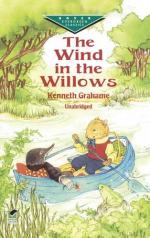|
This section contains 6,660 words (approx. 23 pages at 300 words per page) |

|
SOURCE: Thum, Maureen. “Exploring ‘The Country of the Mind’: Mental Dimensions of Landscape in Kenneth Grahame's The Wind in the Willows.” Children's Literature Association Quarterly 17, no. 3 (fall 1992): 27-32.
In the following essay, Thum explores the theme of journeys—mental and physical—in The Wind in the Willows.
In a 1913 essay entitled “The Fellow that Goes Alone,” Kenneth Grahame speaks of the “country of the mind,” a place to be found during his long, solitary walks in the countryside (Green 6).1 It is a magical territory where ordinary reality can and often does undergo a transformation or transfiguration. In the essay, Grahame retells the legend of “a certain English saint—Edmund Archbishop and confessor,” who had a vision: “a fayr chylde in whyte clothynge which sayd ‘Hayle, felowe that goest alone.’” Grahame describes those who, like Edmund, “choose to walk alone”: They know the special grace attaching to it, and...
|
This section contains 6,660 words (approx. 23 pages at 300 words per page) |

|


